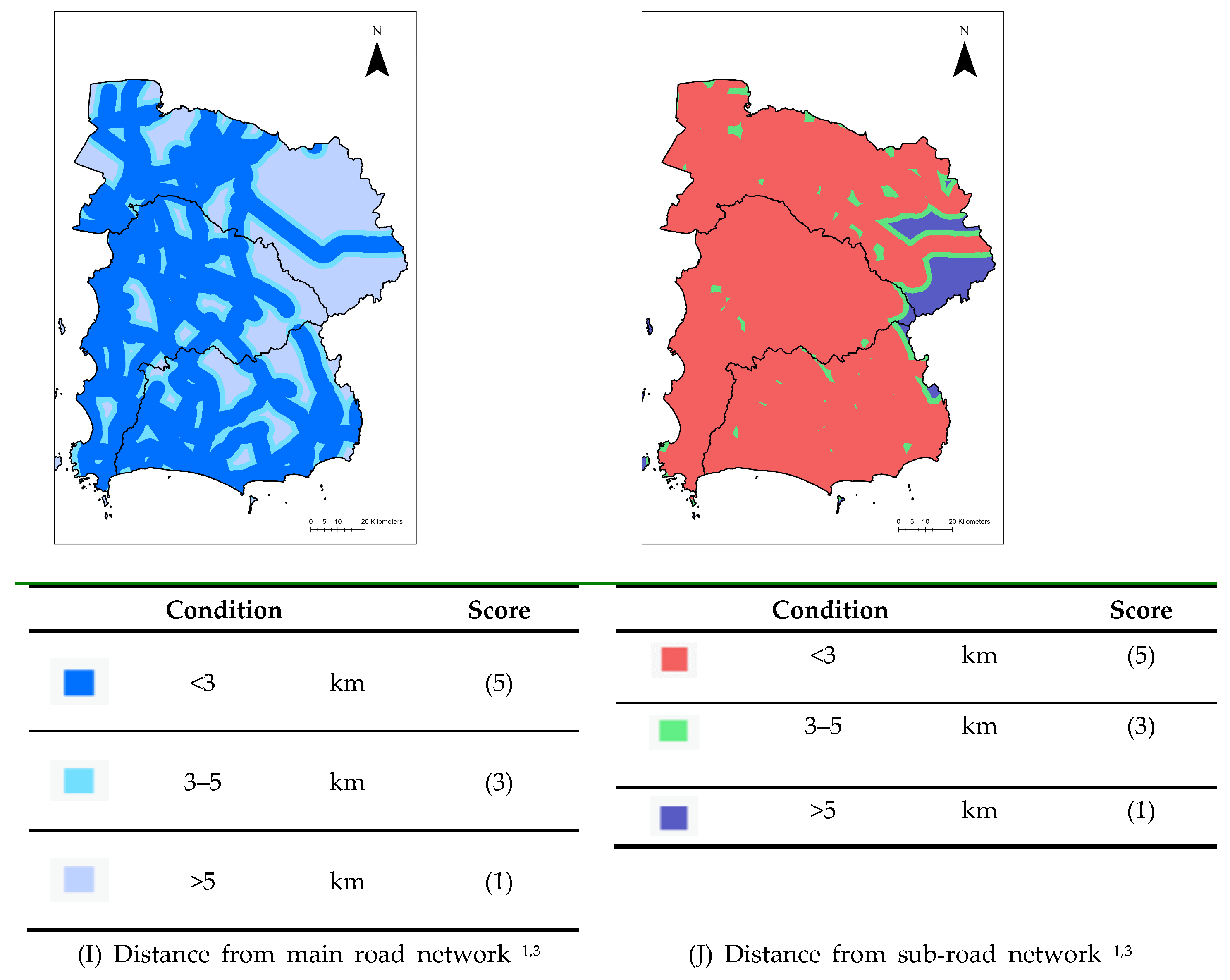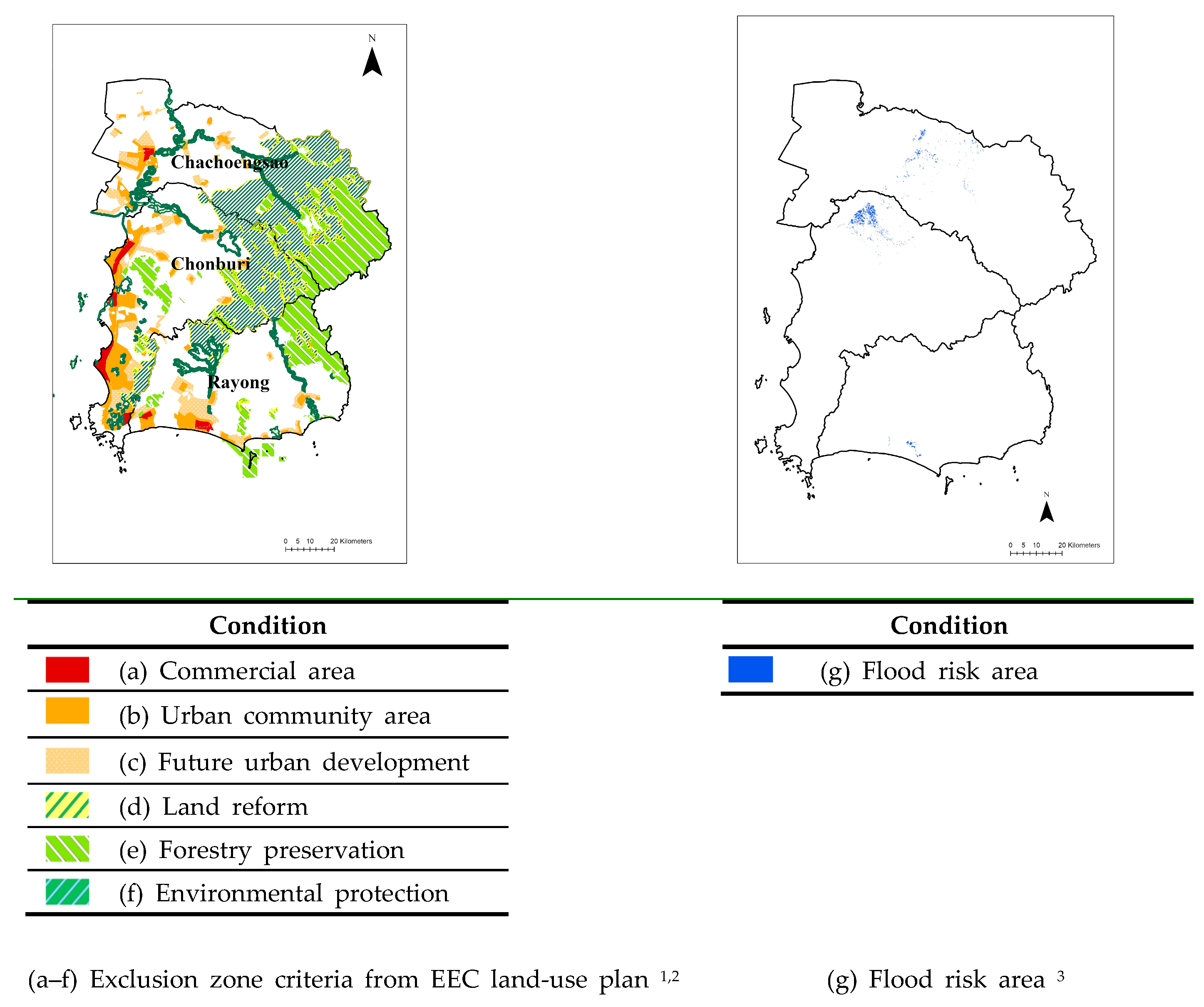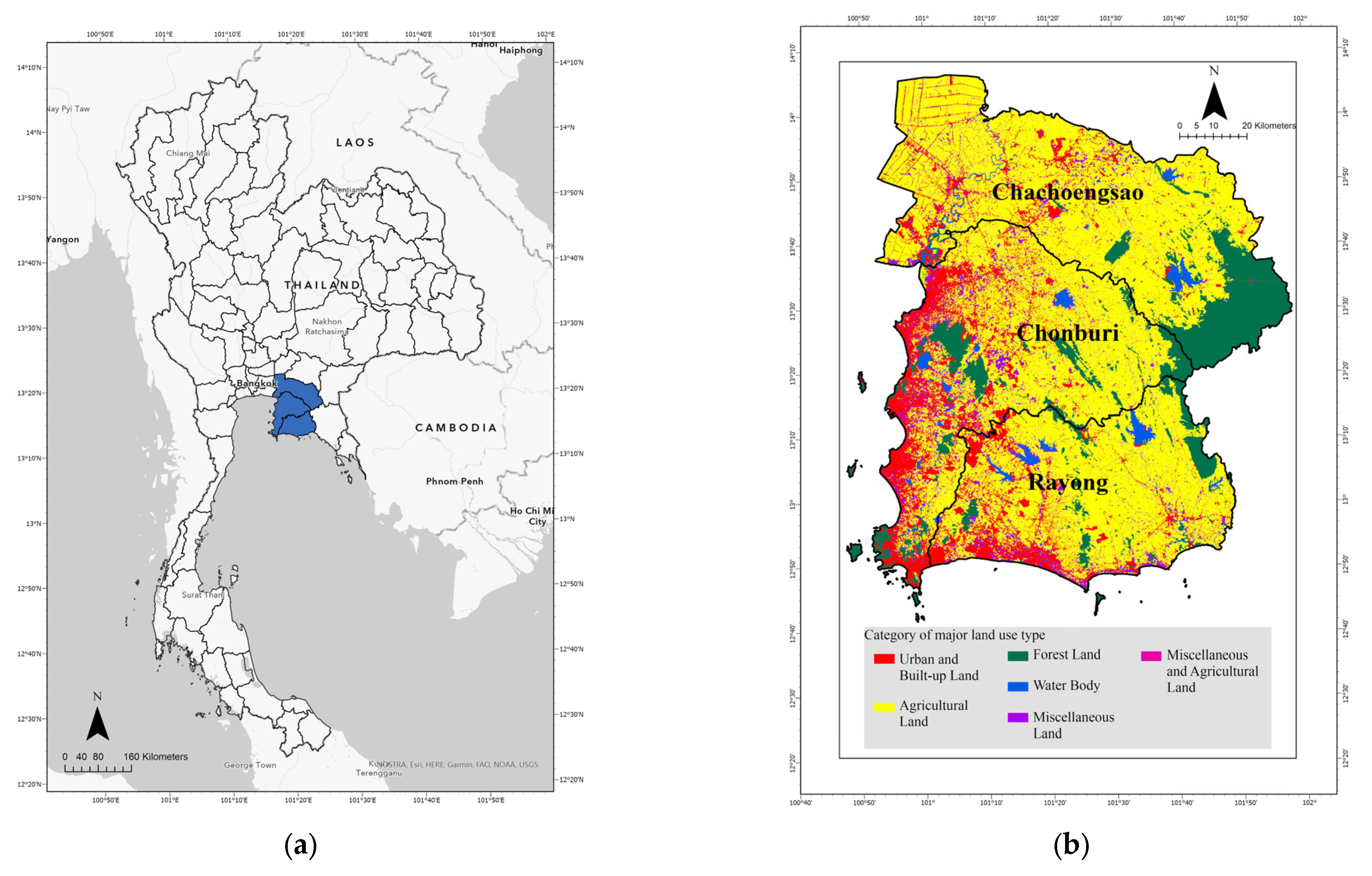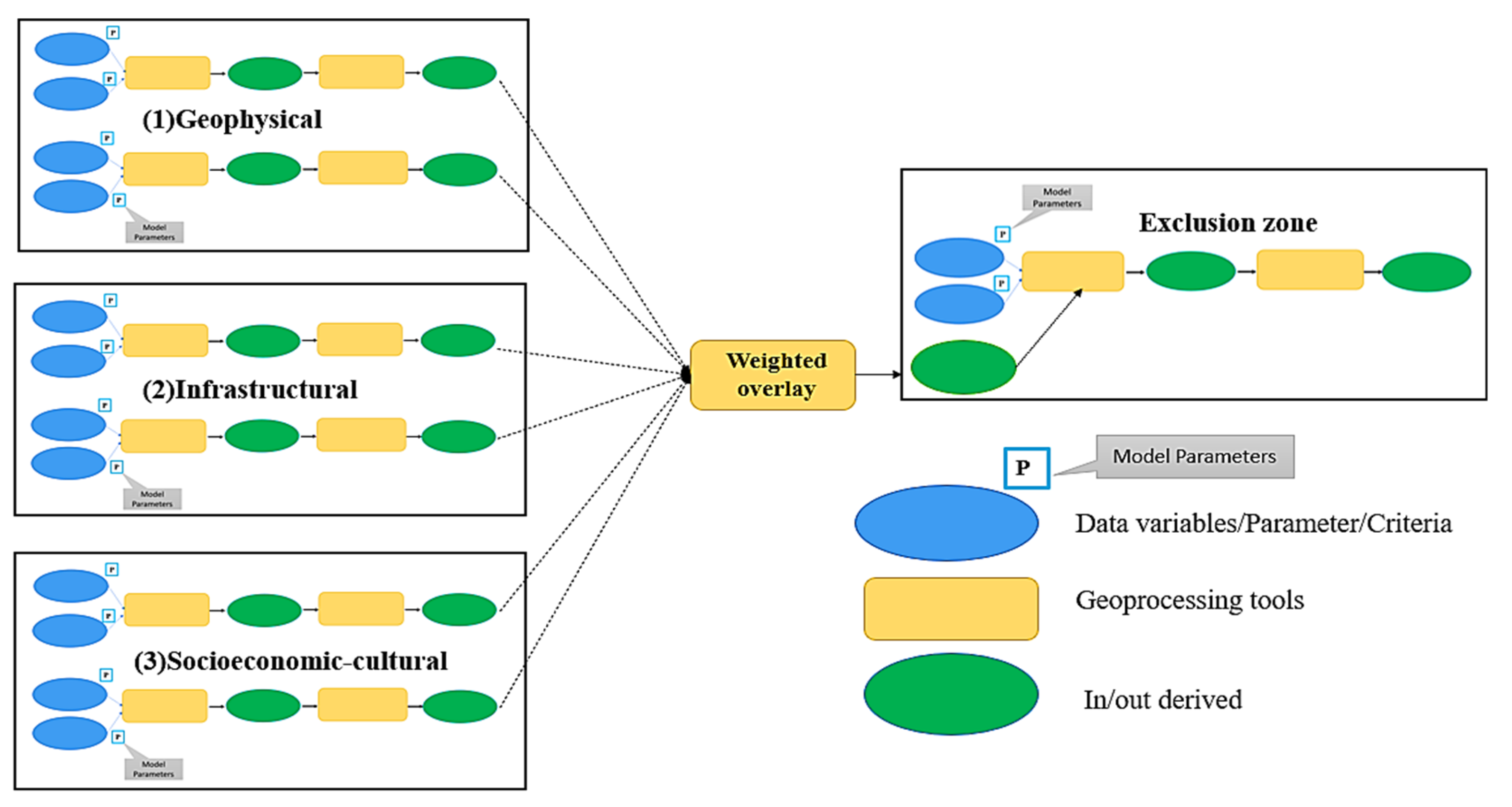Spatial Multi-Criteria Land Suitability Analysis for Community-Scale Biomass Power Plant Site Selection
Abstract
1. Introduction
2. Materials and Methods
2.1. Study Area
2.2. Modeling Tool and Platform Enhancement
2.2.1. Geospatial Dataset, Visual Programming, and Automated Geospatial-Based MCDM–AHP Modeling
2.2.2. Criteria Determination and Priority Weights
- (1)
- Confidentiality and anonymity were guaranteed and communicated to all participants.
- (2)
- There was minimal risk to the participants, as involvement was limited to completing an online questionnaire.
- (3)
- Clear communication of the study’s purpose and scope was included in the questionnaire.
2.3. Evaluation Criteria, Data Types, and Data Sources
- Geographical criteria
- Infrastructural criteria
- Socioeconomic–cultural criteria
- Exclusion zone criteria
| Main Criteria | Sub-Criteria | Data Format | Sources | Year |
|---|---|---|---|---|
| 1. Geographical | Biomass feedstock potential | Polygon | 2 LDD/4 OAE | 2019/2020 |
| Waterbody | 3 DPT/1 EECO | 2019 | ||
| Agricultural promotion zone | 3 DPT/1 EECO | 20-year land-use plan (2018–2037) | ||
| Industrial development zone | 3 DPT/1 EECO | |||
| Slope data | 5 DEM | 2019 | ||
| 2. Infrastructural | Transmission/distribution of power lines | Line | 1 DPT/6 PEA | 2020 |
| Power substation | Point | 3 DPT/1 EECO | 2019/2020 | |
| Existing biomass VSPPs | 3 DPT/1 EECO | 2019/2020 | ||
| Main road network | Line | 1 DPT/1 EECO | 2019 | |
| Sub-road network | 1 DPT/1 EECO | 2019 | ||
| 3. Socioeconomic–cultural | Potential land for rural community development | Polygon | 1 DPT/1 EECO | 20-year land-use plan (2018–2037) |
| Important locations (hospitals and schools) | Point | 2 LDD | 2019 | |
| Local community participation and public acceptance | 3 DPT/1 EECO | 2019/2020 | ||
| 4. Exclusion zone | Commercial and urban community area | Polygon | 3 DPT/2 EECO | 20-year land-use plan (2018–2037) |
| Future urban development | 3 DPT/1 EECO | |||
| Environmental protection | 3 DPT/1 EECO | |||
| Land reform | 3 DPT/1 EECO | |||
| Forest preservation | 3 DPT/1 EECO | |||
| Flood risk area | 7 GISTDA | 2020 |
2.4. Biomass Resource Potential Assessment
- CAi is the plantation area of crop in hectares (ha);
- CPi is the productivity of crop , measured in tonnes per hectare (tonnes/ha);
- RPRi,j is the residue to product ratio of crop type and crop residue type (i or j = 1, 2, …, );
- MCi,j (%) is the moisture content for crop residue type
- Unused fraction (%) is the percentage of biomass not currently diverted to other energy or agricultural uses.
2.5. Setup of the Geospatial Dataset Structure and Modeling Tool Preparation
2.6. Criterion Weight Assessment Using the AHP Technique
2.7. Determining the Relative Score Range of the Land Suitability Map
- (a)
- An evaluation scale was applied to the raster input cell values, allowing for arithmetic operations across layers with differing initial scales. The default values of each raster cell were adjusted based on their relative suitability or importance for the criteria being analyzed.
- (b)
- Weights were assigned to each raster input that reflect the relative importance of each sub-criterion. The total combined weight of all raster layers was constrained to equal 100%. Specifically, the thirteen sub-criteria used in the model were each assigned a weight ranging from 10 to 100, in accordance with their influence on suitability. Land suitability was categorized using scores of 0, 1, 3, and 5, which indicated that the land was unsuitable, marginally suitable, moderately suitable, and highly suitable, respectively. These classifications were derived from statistically significant clusters following the FAO guidelines (1976) [37]. This approach allowed for a quantitative determination of relative suitability score ranges beyond the qualitative limitations of the FAO 1976 framework. The individual land suitability characteristics—such as slope, distance from power lines, main sub-road network feedstock potential, and grid proximity—were standardized using fuzzy membership functions to establish a continuous suitability scale. The relative importance of these criteria was objectively weighted using the Analytic Hierarchy Process (AHP), refined through expert input, and validated using initial sensitivity analysis. A weighted linear combination within a GIS environment then generated a continuous land suitability index from which final suitability classes (e.g., highly, moderately, and marginally suitable, and not suitable) were derived using Natural Breaks (Jenks) as one of optimization methods, providing a robust, data-driven, and spatially differentiated assessment for the EEC study area [36].
- (c)
- The Weighted Overlay tool was then employed to compute the final suitability map. Each cell value in the raster input was multiplied by its corresponding weight (as shown in Table 2). The results were then aggregated across all layers, producing a weighted rank-sum output, which was calculated using
3. Results and Discussion
3.1. Crop Residue Potential in the EEC Region
3.2. Estimation of Criteria Weights with GIS-Based MCDM and AHP Framework
3.3. Land Suitability Map
- (1)
- (2)
- (3)





- Chachoengsao province, including the grided boundary zone of (a) Bang Nam Priao, (b) Mueang, (c) Phanom Sarakham, and (d) Ban Pho;
- Chonburi province, including the grided boundary zone of (e) Si Racha;
- Rayong province, including the grided boundary zone of (f) Mueang Rayong and (g) Klaeng.

4. Conclusions
Author Contributions
Funding
Data Availability Statement
Acknowledgments
Conflicts of Interest
References
- Musolino, M.; Maggio, G.; D’Aleo, E.; Nicita, A. Three case studies to explore relevant features of emerging renewable energy communities in Italy. Renew. Energy 2023, 210, 540–555. [Google Scholar] [CrossRef]
- DEDEa (Department of Alternative Energy Development and Efficiency). The Alternative Energy Development Plan (AEDP 2018–2037). 2018. Available online: https://policy.asiapacificenergy.org/sites/default/files/Alternative%20Energy%20Development%20Plan%202018-2037%20%28AEDP%202018%29%28TH%29.pdf (accessed on 14 February 2023).
- EPPO (Energy Policy and Planning office). Thailand’s Power Development Plan (PDP) 2018–2037 (Revision 1). 2020. Available online: https://www.eppo.go.th/images/Infromation_service/public_relations/PDP2018/PDP2018Rev1.pdf (accessed on 20 February 2020).
- ERC (Energy Regulatory Commission and Office of the Energy Regulatory Commission). Community Power Plant (Pilot Project 150 MW). 2021. Available online: https://www.erc.or.th/th/power-purchasing3/2711 (accessed on 16 February 2023).
- Petrillo, A.; Salomon, V.A.P.; Tramarico, C.L. State-of-the-Art Review on the Analytic Hierarchy Process with Benefits, Opportunities, Costs, and Risks. J. Risk Financ. Manag. 2023, 16, 372. [Google Scholar] [CrossRef]
- Elkadeem, M.R.; Younes, A.; Sharshir, S.W.; Campana, P.E.; Wang, S. Sustainable siting and design optimization of hybrid renewable energy system: A geospatial multi-criteria analysis. Appl. Energy 2021, 295, 117071. [Google Scholar] [CrossRef]
- Budak, G.; Chen, X.; Celik, S.; Ozturk, B. A systematic approach for assessment of renewable energy using analytic hierarchy process. Energy Sustain. Soc. 2019, 9, 37. [Google Scholar] [CrossRef]
- Çolak, Z. A hybrid MCDM method for enhancing site selection for wind power plants in Turkey. Energy Sustain. Dev. 2024, 82, 101536. [Google Scholar] [CrossRef]
- Ghosh, S.; Chakraborty, T.; Saha, S.; Majumder, M.; Pal, M. Development of the location suitability index for wave energy production by ANN and MCDM techniques. Renew. Sustain. Energy Rev. 2016, 59, 1017–1028. [Google Scholar] [CrossRef]
- Agliata, R.; Busato, F.; Presciutti, A. MCDM-Based Analysis of Site Suitability for Renewable Energy Community Projects in the Gargano District. Sustainability 2025, 17, 6376. [Google Scholar] [CrossRef]
- Effatpanah, S.K.; Ahmadi, M.H.; Aungkulanon, P.; Maleki, A.; Sadeghzadeh, M.; Sharifpur, M. Comparative Analysis of Five Widely-Used Multi-Criteria Decision-Making Methods to Evaluate Clean Energy Technologies: A Case Study. Sustainability 2022, 14, 1403. [Google Scholar] [CrossRef]
- Natarajan, K.; Latva-Käyrä, P.; Zyadin, A.; Pelkonen, P. New methodological approach for biomass resource assessment in India using GIS application and land use/land cover (LULC) maps. Renew. Sustain. Energy Rev. 2016, 63, 256–268. [Google Scholar] [CrossRef]
- Bharti, A.; Paritosh, K.; Mandla, V.R.; Chawade, A.; Vivekanand, V. GIS Application for the Estimation of Bioenergy Potential from Agriculture Residues: An Overview. Energies 2021, 14, 898. [Google Scholar] [CrossRef]
- Sahoo, S.K.; Pamucar, D.; Goswami, S.S. A Review of Multi-Criteria Decision-Making Applications to Solve Energy Management Problems from 2010-2025: Current State and Future Research. Spectr. Decis. Mak. Appl. 2025, 2, 219–241. [Google Scholar] [CrossRef]
- Ali, S.; Taweekun, J.; Techato, K.; Waewsak, J.; Gyawali, S. GIS based site suitability assessment for wind and solar farms in Songkhla, Thailand. Renew. Energy 2019, 132, 1360–1372. [Google Scholar] [CrossRef]
- Waewsak, J.; Ali, S.; Gagnon, Y. Site suitability assessment of para rubberwood-based power plant in the southernmost provinces of Thailand based on a multi-criteria decision-making analysis. Biomass Bioenergy 2020, 137, 105545. [Google Scholar] [CrossRef]
- Sekeroglu, A. Site selection for biomass-solar hybrid renewable energy facilities: Spatial modelling based on fuzzy logic-geographic information systems. Renew. Energy 2024, 237, 121775. [Google Scholar] [CrossRef]
- ESRI (Environmental Systems Research Institute). ArcGIS Pro Software, license 3.0.2; ESRI: Redlands, CA, USA, 2020.
- BOI (Thailand Board of Investment), Thailand’s Eastern Economic Corridor (EEC). The Special Economic Zone (SEZ) for the Future of ASEAN. 2016. Available online: https://www.boi.go.th/en/Policy_EEC (accessed on 2 February 2020).
- LDD (Land Development Department). Land Use (GIS Databased) in the Year 2019/2020; Ministry of Agriculture and Cooperatives: Bangkok, Thailand, 2020. Available online: https://dinonline.ldd.go.th/Login.aspx?service=3 (accessed on 20 February 2020).
- Boonman, A.; Fukuda, S.; Tiwari, S.; Kraxner, F. Two-Phase Approach for Designing Sustainable Biomass Supply Chains for Community-Scale Biomass Power Plants in Thailand. Energies 2025, 18, 520. [Google Scholar] [CrossRef]
- ESRI (Environmental Systems Research Institute). Geoprocessing (Model Builder); ESRI: Redlands, CA, USA, 2020. [Google Scholar]
- DEDEb (Department of Alternative Energy Development and Efficiency). Biomass Potential Database System in Thailand. 2014. Available online: https://gis.dede.go.th/module/map/index.aspx (accessed on 25 February 2020).
- Saaty, T.L. Textbook of the Analytic Hierarchy Process, Planning, Priority Setting, Resources Allocation; McGraw-Hill: New York, NY, USA, 1980; pp. 271–278. [Google Scholar]
- Saaty, T.L. Decision-making with the AHP: Why is the principal eigenvector necessary. Eur. J. Oper. Res. 2003, 145, 85–91. [Google Scholar] [CrossRef]
- DPT (Department of Public Works and Town & Country Planning). GIS Data in Land Use Plan (2037) Data for The Eastern Economic Corridor (EEC) 20-Year; The Eastern Economic Corridor Office of Thailand (EECO): Bangkok, Thailand, 2020. [Google Scholar]
- OAE (Office of Agricultural Economics). Agricultural Statistics of Thailand Fiscal Year 2019/2020; Ministry of Agriculture and Cooperatives: Bangkok, Thailand, 2019. Available online: https://oae.go.th/home/article/393 (accessed on 20 February 2023).
- DEM. Digital Elevation Model from NASA’s Earth Science Data Systems (ESDS) Program. Available online: https://www.earthdata.nasa.gov/esds (accessed on 18 February 2023).
- PEA (Provincial Electricity Authority). Transmission Lines and Distribution Power Lines (115 kV/22kV) in Digital File for The Eastern Economic Corridor (EEC); Ministry of Interior: Bangkok, Thailand, 2022.
- EECO (Eastern Economic Corridor Office of Thailand). Agriculture and Cooperatives. Overall Land Use Plan. 2020. Available online: https://eeco.or.th/th/overall-land-use-plan (accessed on 15 May 2021).
- GISTDA (Geo-Informatics and Space Technology Development Agency (Public Organization). Flood Risk Area. 2020. Available online: https://disaster.gistda.or.th/flood (accessed on 15 May 2021).
- Cheewaphongphan, P.; Junpen, A.; Kamnoet, O.; Garivait, S. Study on the Potential of Rice Straws as a Supplementary Fuel in Very Small Power Plants in Thailand. Energies 2018, 11, 270. [Google Scholar] [CrossRef]
- DEDEc (Department of Alternative Energy Development and Efficiency); ESCAP (The United Nations Economic and Social Commission for Asia and the Pacific). Pilot Training on Power and Heat Generation from Biomass Under the Project “Building Capacity of ASEAN Countries in Biomass Energy Development through Local Capacity Development”. In Handbook for Pilot Training; Department of Alternative Energy Development and Efficiency: Bangkok, Thailand, 2020; pp. 2–16. [Google Scholar]
- Sugathapala, A.G.T. Feasibility of Small Scale Biomass Power Plants in Sri Lanka. Prepared for Biomass Energy 2022 Project United Nations Development Programme (UNDP). 2020. Available online: https://www.undp.org/sites/g/files/zskgke326/files/migration/lk/Feasibility-of-BM-Power-Plants.pdf (accessed on 15 February 2023).
- Hytönen, J.; Kaakkurivaara, N.; Kaakkurivaara, T.; Nurmi, J. Biomass Equations for Rubber Tree (Hevea Brasiliensis) Components in Southern Thailand. J. Trop. For. Sci. 2018, 30, 588–596. [Google Scholar] [CrossRef]
- ESRI (Environmental Systems Research Institute). Reclassify Method in ArcGIS Pro Software; ESRI: Redlands, CA, USA, 2020. [Google Scholar]
- FAO (Food and Agriculture Organization of the United Nations). A Framework for Land Evaluation. Soils Bulletin No. 32; FAO: Rome, Italy, 1976. [Google Scholar]




| 1 | 2 | 3 | 4 | 5 | 6 | 7 | 8 | 9 | 10 | 11 | 12 | 13 | |
|---|---|---|---|---|---|---|---|---|---|---|---|---|---|
| RI | 0.00 | 0.00 | 0.58 | 0.90 | 1.12 | 1.24 | 1.32 | 1.41 | 1.45 | 1.49 | 1.52 | 1.54 | 1.56 |
| Crop | Total Crop Production (kt) 1 | Residues Type 1 | Residue-to-Product Ratio (RPR) 2 | Moisture Content (%) 2 | Crop Residues Generated (kt, Dry Matter) 2 | Unused Fraction (%) 2 | Crop Residues Remaining (kt, Dry Matter) 2 | Lower Heating Value or LHV (MJ/kg) 3 | Available Energy Potential (TJ) 3 |
|---|---|---|---|---|---|---|---|---|---|
| Sugarcane | 17,090 | Tops and leaves | 0.192 | 9.20 | 2986 | 59.2 | 1767 | 15.48 | 27,360 |
| Bagasse | 0.279 | 50.73 | 2349 | 0 | 0 | 7.37 | 0 | ||
| Palm | 432 | Palm trunk | 1.000 | 48.40 | 223 | 89.9 | 200 | 7.54 | 1511 |
| Palm empty fruit bunch | 0.200 | 58.60 | 31 | 0 | 0 | 7.24 | 0 | ||
| Palm fronds and leaves | 0.199 | 78.00 | 19 | 15.9 | 3 | 1.76 | 5 | ||
| Palm fiber | 0.131 | 38.50 | 35 | 0 | 0 | 11.40 | 0 | ||
| Palm shell | 0.056 | 12.00 | 21 | 0 | 0 | 16.90 | 0 | ||
| First-crop rice | 412 | Rice straw | 1.256 | 10.00 | 466 | 27.7 | 129 | 12.33 | 1591 |
| Rice husk | 0.262 | 10.00 | 97 | 0 | 0 | 13.52 | 0 | ||
| Second-crop rice | 468 | Rice straw | 1.256 | 10.00 | 529 | 27.7 | 147 | 12.33 | 1808 |
| Rice husk | 0.262 | 10.00 | 110 | 0 | 0 | 13.52 | 0 | ||
| Cassava | 1580 | Cassava trunk | 0.333 | 59.40 | 214 | 46 | 98 | 15.59 | 1532 |
| Cassava rhizome | 0.096 | 59.40 | 62 | 55.8 | 35 | 5.49 | 190 | ||
| Para rubber | 103 | Rubber tree root | 0.569 | 40.00 | 35 | 68.8 | 24 | 6.57 | 159 |
| Rubber tree twig | 0.177 | 55.00 | 8 | 0 | 0 | 6.57 | 0 | ||
| Rubber tree leaves | 0.083 | 55.00 | 4 | 0 | 0 | 6.57 | 0 | ||
| Rubberwood chips/wings | 0.440 | 55.00 | 20 | 0 | 0 | 6.57 | 0 | ||
| Gross crop residue potential | 7209 | 2403 | 34,156 | ||||||
| Main Criteria | Sub-Criteria | Weight Priorities | Criteria Weight (%) | Priority Rank (Preference) | Standard Deviation (S.D) (σ) |
|---|---|---|---|---|---|
| Geographical | Biomass resources/feedstock potential | 0.1849 | 18.49 | 1 | ±8.8% |
| Waterbody | 0.1819 | 18.19 | 2 | ±7.8% | |
| Agricultural promotion zone | 0.0512 | 5.12 | 6 | ±2.9% | |
| Industrial development | 0.0509 | 5.09 | 7 | ±2.7% | |
| Slope | 0.0225 | 2.25 | 12 | ±1.1% | |
| Infrastructural | Distribution of power lines | 0.1041 | 10.41 | 4 | ±4.4% |
| Power substation | 0.0432 | 4.32 | 8 | ±2.0% | |
| Existing biomass for VSPPs | 0.0366 | 3.66 | 9 | ±1.8% | |
| Main road network | 0.0299 | 2.99 | 11 | ±1.4% | |
| Sub-road network | 0.0161 | 1.61 | 13 | ±0.8% | |
| Socioeconomic–cultural | Potential land for rural community development | 0.0319 | 3.19 | 10 | ±1.4% |
| Important places (hospitals and schools) | 0.0708 | 7.08 | 5 | ±3.7% | |
| Local community participation and public acceptance | 0.1759 | 17.59 | 3 | ±8.9% | |
| Total | 1 | 100 | (1–13) | - |
Disclaimer/Publisher’s Note: The statements, opinions and data contained in all publications are solely those of the individual author(s) and contributor(s) and not of MDPI and/or the editor(s). MDPI and/or the editor(s) disclaim responsibility for any injury to people or property resulting from any ideas, methods, instructions or products referred to in the content. |
© 2025 by the authors. Licensee MDPI, Basel, Switzerland. This article is an open access article distributed under the terms and conditions of the Creative Commons Attribution (CC BY) license (https://creativecommons.org/licenses/by/4.0/).
Share and Cite
Boonman, A.; Fukuda, S.; Junpen, A. Spatial Multi-Criteria Land Suitability Analysis for Community-Scale Biomass Power Plant Site Selection. Energies 2025, 18, 4469. https://doi.org/10.3390/en18174469
Boonman A, Fukuda S, Junpen A. Spatial Multi-Criteria Land Suitability Analysis for Community-Scale Biomass Power Plant Site Selection. Energies. 2025; 18(17):4469. https://doi.org/10.3390/en18174469
Chicago/Turabian StyleBoonman, Athipthep, Suneerat Fukuda, and Agapol Junpen. 2025. "Spatial Multi-Criteria Land Suitability Analysis for Community-Scale Biomass Power Plant Site Selection" Energies 18, no. 17: 4469. https://doi.org/10.3390/en18174469
APA StyleBoonman, A., Fukuda, S., & Junpen, A. (2025). Spatial Multi-Criteria Land Suitability Analysis for Community-Scale Biomass Power Plant Site Selection. Energies, 18(17), 4469. https://doi.org/10.3390/en18174469










